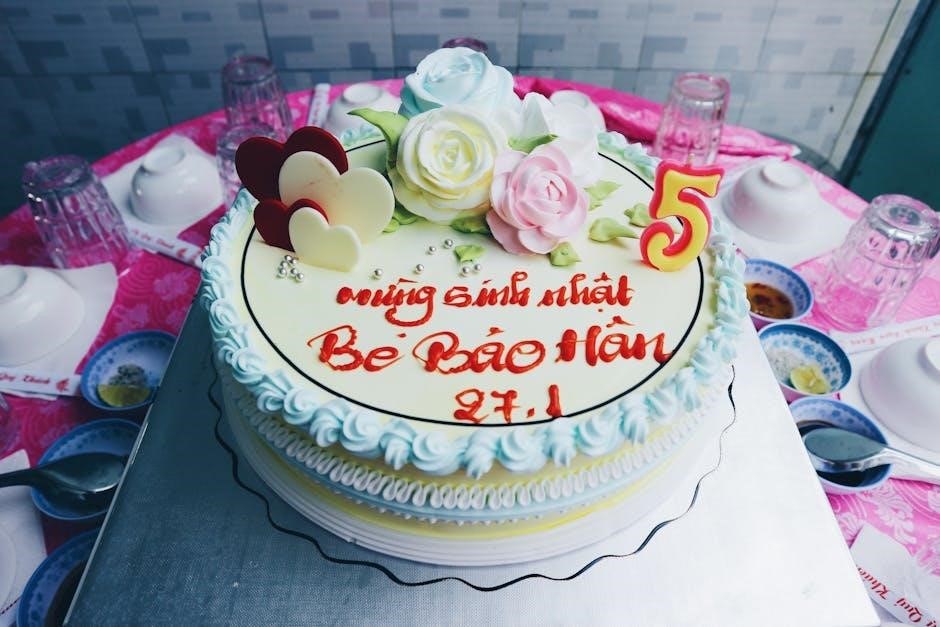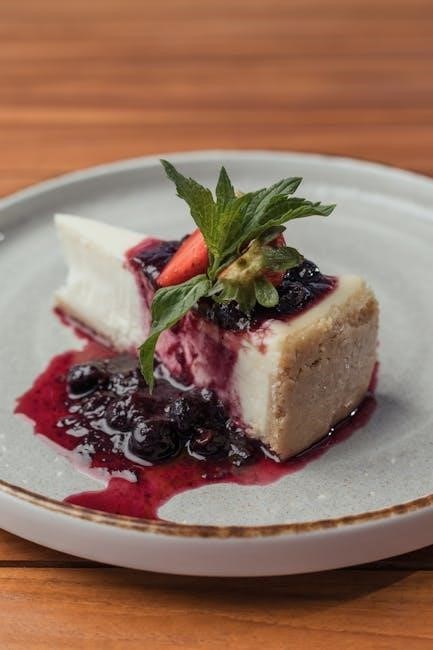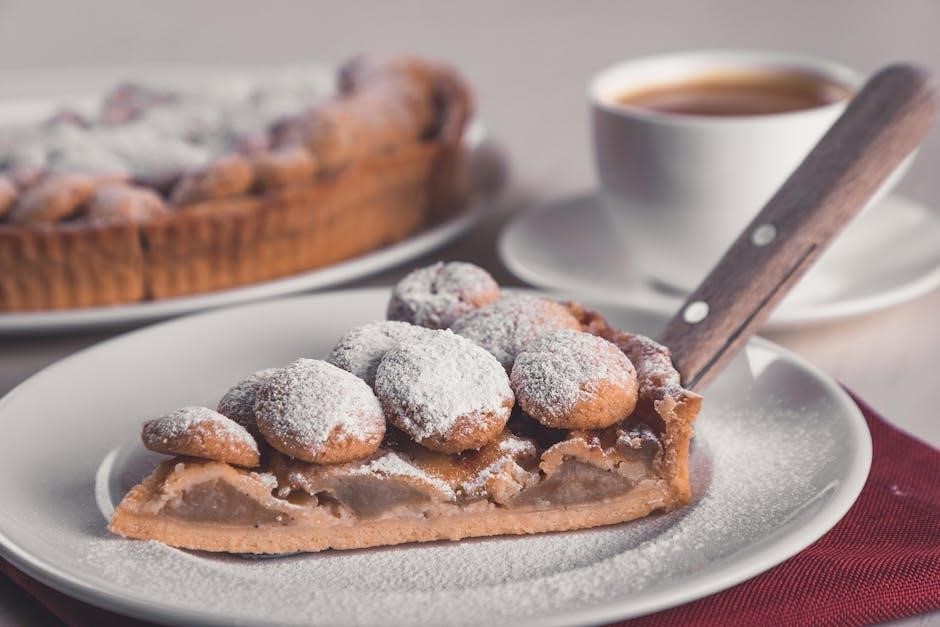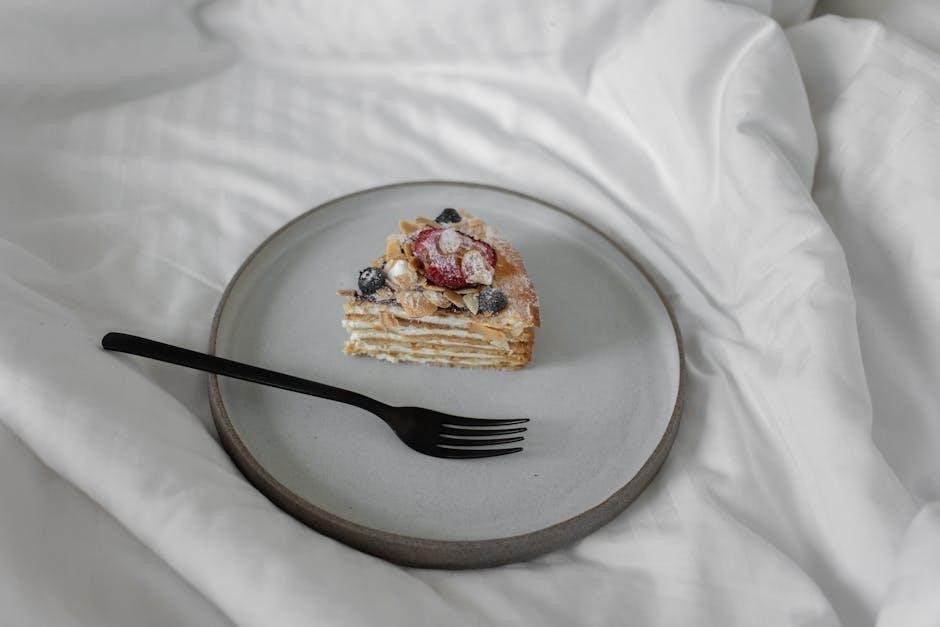Welcome to the ultimate cake serving guide, designed to help you determine the perfect portion sizes for any event․ Learn how to plan and serve cakes efficiently, ensuring everyone enjoys a delightful slice․ This guide covers essential tips, portion calculations, and serving styles to make your cake stand out at weddings, parties, or gatherings․ Whether you’re a professional baker or a home cook, this guide will help you master the art of cake serving․
1․1 Importance of Proper Cake Serving
Proper cake serving ensures guest satisfaction, avoids waste, and maintains the cake’s visual appeal․ Correct portioning guarantees everyone enjoys an equal share, while also considering dietary preferences․ Accurate serving sizes prevent overconsumption or scarcity, making events memorable․ Proper techniques enhance presentation, preserving the cake’s artistic design․ Additionally, precise serving aligns with event themes, whether formal or casual, ensuring a seamless experience․ By mastering cake serving, hosts can create lasting impressions, making every celebration delightful and stress-free․ This guide provides expert tips to achieve perfection in cake serving, ensuring your event is both enjoyable and visually stunning․
1․2 Basic Concepts of Cake Portioning
Understanding cake portioning involves knowing standard serving sizes and how to calculate portions based on cake dimensions․ A typical serving size is a slice measuring 1×2 inches for weddings and 1․5×2 inches for parties․ Cake shape and height also impact portioning, with round cakes yielding different servings than square ones․ For example, an 8-inch round cake typically serves 8-12 people, while a 9×13-inch square cake serves 12-15․ Portioning is influenced by the cake’s height, with taller cakes offering more slices․ These calculations help ensure every guest receives a fair share, making cake portioning a crucial skill for bakers and event planners alike․ Proper portioning enhances both presentation and guest satisfaction, ensuring a memorable experience․
Understanding Cake Serving Sizes
Standard cake serving sizes vary by event type, with wedding slices typically being 1×2 inches and party slices 1․5×2 inches․ Round and square cakes yield different servings based on their dimensions․
2․1 Standard Cake Serving Size
A standard cake serving size is generally considered to be a slice measuring approximately 1 inch in width and 2 inches in length․ This size is typical for both round and square cakes, ensuring consistency across different shapes․ The serving size is designed to provide a generous yet balanced portion, making it suitable for various events․ Whether it’s a wedding or a party, this standard size helps in planning and portioning accurately; By adhering to this measurement, hosts can ensure that each guest receives an equal and satisfying slice of cake․
2․2 Party vs․ Wedding Serving Portions
Party and wedding serving portions differ slightly, impacting how cakes are portioned․ Wedding servings are typically smaller, measuring about 1 inch wide and 2 inches long, allowing for more servings and a more formal presentation․ Party servings, however, are slightly larger, often 1․5 inches wide and 2 inches long, catering to heartier appetites․ These distinctions help in planning cake sizes and ensuring enough slices for guests․ Understanding these portion differences is key to accurately determining the number of servings and selecting the right cake size for your event․
2․3 Factors Affecting Portion Sizes
Several factors influence cake portion sizes, including cake height, shape, and tiered designs․ Taller cakes (3-6 inches high) yield the same servings as shorter ones if baked in the same pan size․ Round and square cakes differ in portion calculations due to their shapes․ Tiered cakes require calculating servings per tier, as each tier’s size varies․ Additionally, serving style—whether slices are cut thinly for weddings or generously for parties—affects the total number of servings․ Understanding these factors helps in accurately determining portion sizes and ensuring your cake meets the needs of your event․

How to Determine the Number of Servings
Calculate servings by considering cake size, shape, and height․ Round cakes are cut into triangular slices, while square cakes are divided into equal-sized squares․ Taller cakes yield the same servings as shorter ones if baked in the same pan size․ Use these measurements to plan your cake precisely for any event․
3․1 Calculating Servings Based on Cake Size
Calculating servings based on cake size involves considering the cake’s dimensions and standard serving sizes․ For round cakes, an 8-inch cake typically serves 8 to 16 people, depending on slice size․ A 10-inch round cake can serve up to 39 people with smaller slices․ For square cakes, a 9×9 inch cake generally serves 9 to 12 people, as it can be cut into equal-sized squares․ Party servings are usually larger (1․5 x 2 inches), while wedding servings are smaller (1 x 2 inches)․ The number of servings can be estimated by calculating the cake’s area and dividing by the standard serving size area․ This method works for both round and square cakes, allowing accurate portion planning for any event․
3․2 Calculating Servings Based on Cake Shape
Cake shape significantly impacts serving calculations․ Round cakes are typically cut into triangular slices, with servings based on diameter and slice width․ For example, an 8-inch round cake can serve 8 to 16 people, depending on slice size․ Square cakes, cut into equal-sized squares or rectangles, often yield more uniform portions․ A 9×9 inch square cake typically serves 9 to 12 people․ Shape influences both the number of servings and visual presentation․ Round cakes may have more variability in slice size, while square cakes offer greater portion control․ Understanding how shape affects servings is crucial for accurate portion planning, ensuring your cake meets the demands of any event or celebration․
3․3 Calculating Servings Based on Cake Height
Cake height plays a crucial role in determining servings, as taller cakes can often be cut into more layers or thinner slices․ A standard cake height of 3 to 4 inches typically yields consistent portion sizes․ However, taller cakes (5 to 6 inches) can be sliced horizontally into multiple layers, increasing the number of servings․ For example, a 3-inch tall cake might serve 8 to 12 people, while a 6-inch tall cake could serve 12 to 16, depending on how it’s layered and cut․ Understanding how height affects servings helps in planning the right size for your event, ensuring every guest gets an equal and satisfying portion․

Cake Serving Guide by Shape
This guide helps you determine servings based on cake shape, with round cakes offering triangular slices and square cakes providing equal-sized portions․ Shape impacts serving sizes and cutting ease, ensuring perfect portions every time․
4․1 Round Cake Serving Guide
Round cakes are traditionally cut into triangular slices, making them a popular choice for both weddings and parties․ The number of servings depends on the cake’s diameter and the slice size․ For example, an 8-inch round cake typically serves 8-16 people, while a 12-inch cake can serve up to 26․ Party servings are generally larger (1․5×2 inches), yielding fewer slices, while wedding portions are smaller (1×2 inches), maximizing the number of servings․ To ensure even portions, use a serrated knife and measure slices consistently․ Thinner slices allow more servings, making round cakes versatile for events of any size․
4․2 Square Cake Serving Guide
Square cakes offer a modern and versatile option for serving․ The standard serving size for square cakes is based on 1×2-inch slices for weddings and 1․5×2-inch slices for parties․ A 9×9-inch square cake typically serves 9-18 people, while a 12-inch square cake can serve up to 24․ To ensure even portions, cut the cake into a grid pattern, dividing it into equal-sized squares or rectangles․ For larger events, consider using a cake with deeper layers to maximize servings․ Square cakes are ideal for events requiring uniform slices, and their flat surfaces make them easy to decorate and serve․ Proper cutting techniques ensure every guest enjoys a consistent and delicious portion․

Cutting Techniques for Even Servings
Mastering cutting techniques ensures even cake servings․ Use a serrated knife and even pressure to prevent tearing․ For square cakes, cut in a grid pattern for uniform slices․ This method guarantees consistent portions and a professional presentation at any event․
5․1 Cutting Round Cakes
Cutting round cakes requires precision to ensure even servings․ Start by placing the cake on a rotating stand for better accessibility․ Use a serrated knife and apply even pressure, slicing from the center outward in a radial pattern․ For uniformity, mark the cake edge at equal intervals before cutting․ A standard serving size is a slice about 1 inch wide at the widest point․ An 8-inch round cake typically serves 8-16 people, depending on portion size․ Thinner slices yield more servings, ideal for larger gatherings․ Always cut in a smooth, steady motion to avoid tearing the cake and ensure clean, professional-looking slices for your event․
5․2 Cutting Square Cakes
Cutting square cakes involves creating equal-sized squares or rectangles for uniform servings․ Start by measuring the cake’s edge to determine the number of slices․ For a standard 12-inch square cake, you can yield up to 24 servings when cut into 1․5-inch squares․ Use a long serrated knife and a ruler to guide straight cuts․ Ensure the cake is at room temperature to prevent crumbling․ Begin by cutting the cake into rows, then slice each row into individual portions․ For smaller servings, reduce the slice size to 1 inch wide, increasing the total number of servings․ This method ensures even distribution and a professional presentation for any event․

Serving Styles for Different Events
Party servings are typically larger (1․5×2 inches), while wedding portions are smaller (1×2 inches)․ Adjust slice sizes based on event formality and guest appetite for perfect presentation․
6․1 Wedding Cake Serving Style
Wedding cakes are typically served in smaller, more elegant portions, with slices measuring approximately 1×2 inches․ This smaller size allows for more servings, making it ideal for large gatherings․ The cake is often tiered, with each tier serving a specific number of guests․ To maintain uniformity, slices are cut evenly, ensuring a clean presentation․ For tiered cakes, start cutting from the bottom tier and work upwards․ Use a serrated knife for smooth cuts and a serving spatula for neat portioning․ This method ensures every guest receives a consistent and visually appealing slice, enhancing the overall wedding dining experience․ Proper portioning is key to satisfying all guests without waste․
6․2 Party Cake Serving Style
Party cakes are often served in larger portions compared to wedding cakes, with slices typically measuring 1․5×2 inches․ This larger size accommodates the casual nature of parties, where guests may have bigger appetites․ To ensure even servings, cut the cake into equal slices using a serrated knife․ For round cakes, start from the center and work outward, while for square cakes, divide the cake into equal sections․ Arrange slices on a platter or individual plates for easy access․ Consider adding decorative touches like fresh fruit or frosting drizzle to enhance the presentation․ This style ensures a generous serving size while maintaining a festive and inviting atmosphere for any celebration․
Cake Serving Charts and Tables
Use detailed charts and tables to determine servings for round and square cakes, based on size and slice dimensions, ensuring accurate portion planning for events․
7․1 Round Cake Serving Chart
A round cake serving chart provides a clear guide to determine the number of servings based on the cake’s diameter․ For example, an 8-inch round cake typically serves 8-12 people, while a 9-inch cake serves 12-16․ Larger cakes, such as a 10-inch, can serve 16-20 guests, and a 12-inch cake can serve up to 26 people․ The chart also distinguishes between party-sized portions (1․5 x 2 inches) and wedding-sized portions (1 x 2 inches), helping you plan accurately for any event․ Use this chart to ensure every guest receives a fair and delicious slice, making your cake serving experience seamless and stress-free․
7․2 Square Cake Serving Chart
A square cake serving chart helps estimate servings based on the cake’s side length․ For example, an 8-inch square cake serves 9-12 people, while a 9-inch serves 12-15․ A 10-inch square cake can serve 15-20 guests, and a 12-inch serves up to 24 people․ The chart differentiates between party portions (1․5 x 2 inches) and wedding portions (1 x 2 inches), aiding precise planning․ This guide ensures you can serve square cakes efficiently, making every event enjoyable and well-organized․ Use the chart to avoid over- or underestimating portions, guaranteeing a perfect slice for everyone․
Factors Influencing Serving Sizes
Factors like cake height, tiered designs, and flavor profiles impact serving sizes․ Taller cakes yield more portions, while rich flavors may require smaller slices for guest satisfaction․
8․1 Cake Height and Servings
Cake height significantly affects serving sizes․ Taller cakes, typically 3–6 inches high, can yield more portions due to increased volume․ Standard height cakes (2–3 inches) provide fewer servings․ For example, a 10-inch round cake serves 8–16 people, while taller cakes can serve up to 20․ However, slicing techniques must adjust to maintain consistent portion sizes․ Thinner slices from taller cakes ensure equal servings without overwhelming guests․ This balance is crucial for events requiring precise portion control, making cake height a key factor in serving calculations․
8․2 Tiered Cakes and Servings
Tiered cakes offer a visually stunning and flexible option for serving large groups․ Each tier serves a different number of guests, depending on size and height․ For example, a 3-tier cake with 6-, 8-, and 10-inch tiers can serve 50-100 people․ Smaller tiers yield fewer servings, while larger tiers increase capacity․ Portion sizes remain consistent across tiers, typically 1×2 inches for weddings and 1․5×2 inches for parties․ Calculating servings for tiered cakes involves summing the portions from each tier, ensuring enough for all guests․ This approach is ideal for events requiring varied portion sizes and presentation․
8․3 Flavor and Frosting Impact on Servings
Flavor and frosting significantly influence cake servings, as they affect portion sizes․ Rich or dense cakes, like chocolate or red velvet, may require smaller slices due to their intense taste, while lighter flavors, such as vanilla or carrot cake, can be served in larger portions․ Similarly, frosting quantity and type play a role; heavily frosted cakes may yield fewer servings as they are more filling․ Lighter frostings, such as buttercream, allow for standard portions․ Balancing flavor and frosting ensures guests enjoy satisfying slices without excess․ This consideration is crucial for events, helping hosts choose the right cake size based on taste preferences and expected servings․
Tips for Serving Cakes at Events
Use proper tools like serrated knives and serving spatulas for clean cuts․ Ensure the cake is at room temperature for even slicing․ Plan serving times to maintain freshness and presentation․ Always prioritize hygiene and organization when handling cakes during events․
9․1 Presentation Tips for Cake Serving
Presentation is key to making your cake stand out at any event․ Always use a clean, elegant serving spatula to portion slices neatly․ Consider elevating the cake on a decorative stand to enhance visibility․ Arrange slices symmetrically on a platter or individual plates for a polished look․ Garnish with fresh flowers, berries, or edible decorations to add visual appeal․ Ensure the cake is well-lit to highlight its details․ For tiered cakes, maintain balance and harmony between layers․ Finally, serve with a smile and provide clear labeling for flavors or dietary options to ensure guests know what they’re enjoying․
9․2 Tools Needed for Serving Cakes
To serve cakes effectively, you’ll need the right tools․ A sharp cake knife or serrated knife is essential for clean, precise cuts․ A serving spatula helps in lifting and transferring slices without breaking․ For tiered cakes, a cake stand or multi-tier server adds elegance and visibility․ Use dessert plates or cake stands for individual servings․ A cake lifter or large spatula is handy for moving entire layers․ For decorative touches, consider a piping bag or fondant smoother․ Keep napkins and forks on hand for guests; A cake turntable can also enhance presentation by allowing the cake to be easily viewed from all angles․ These tools ensure a professional and seamless cake-serving experience․
Mastery of cake serving ensures even portions and a visually appealing presentation, making every event a success․ Follow these guidelines to delight your guests with perfection․
10․1 Summary of Cake Serving Guide
This comprehensive guide provides essential insights into cake serving, including portion sizes, shapes, and event-specific styles․ It emphasizes the importance of proper slicing techniques and presentation to ensure even servings․ Factors like cake height, tiers, and flavor impact portion sizes, while tools and tips enhance the serving experience․ Whether for weddings or parties, this guide offers practical advice to help you plan and execute cake servings flawlessly․ By following these guidelines, you can ensure your cake stands out and satisfies every guest, making your event a culinary success․ Use this guide to master the art of cake serving and create unforgettable memories․
10․2 Final Tips for Perfect Cake Servings
For perfect cake servings, always prioritize presentation and timing․ Ensure your cake is well-chilled before slicing to maintain structure and even portions․ Use high-quality serving tools, like sharp knives and sturdy servers, to prevent breakage․ Consider the event style—wedding portions are smaller (1×2 inches), while party slices can be larger (1․5×2 inches)․ Don’t forget to account for tiered cakes, as their servings vary by size and height․ Finally, customize your approach based on guest preferences and dietary needs․ By following these tips, you’ll deliver a memorable and satisfying cake experience at any event․